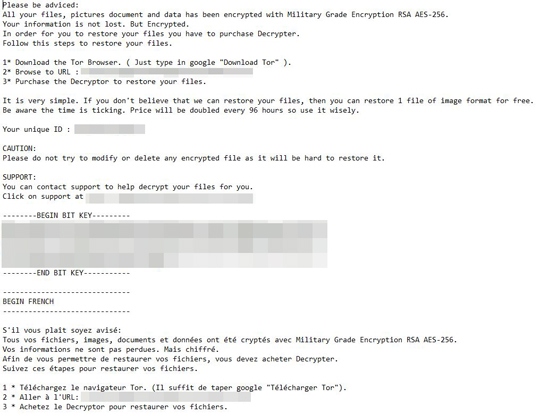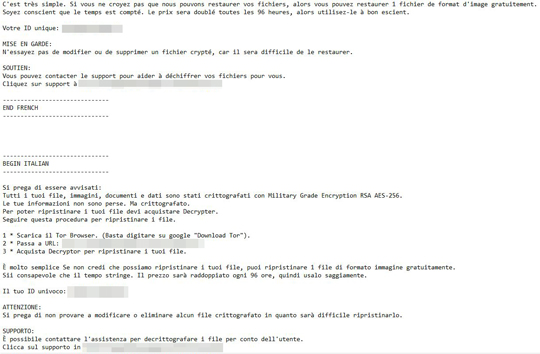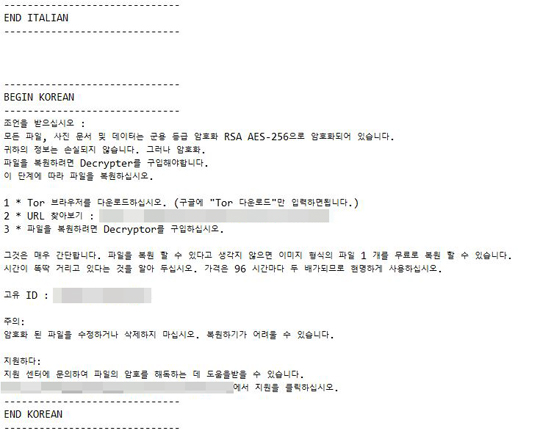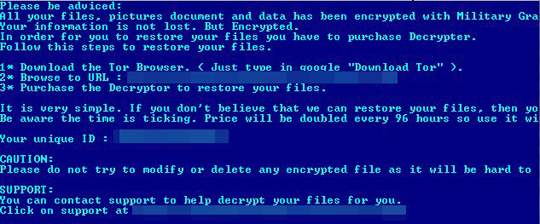RANSOM.PYTHON.PYLOCKY.AOKAM
Python/Filecoder_Locky.B!tr (Fortinet); Trojan-Ransom.Locky (Ikarus); Trojan:Win32/Bitrep.B (Microsoft)
Windows


Threat Type: Ransomware
Destructiveness: No
Encrypted: Yes
In the wild: Yes
OVERVIEW
Spammed via email, Dropped by other malware, Downloaded from the Internet
This Ransomware arrives as an attachment to email messages spammed by other malware/grayware or malicious users. It arrives on a system as a file dropped by other malware or as a file downloaded unknowingly by users when visiting malicious sites.
It creates folders where it drops its files.
It connects to certain websites to send and receive information. It is capable of encrypting files in the affected system.
It encrypts files with specific file extensions. It drops files as ransom note.
TECHNICAL DETAILS
5,531,464 bytes
EXE
Yes
05 Sep 2018
Connects to URLs/IPs, Steals information, Displays message/message boxes, Encrypts files
Arrival Details
This Ransomware arrives as an attachment to email messages spammed by other malware/grayware or malicious users.
It arrives on a system as a file dropped by other malware or as a file downloaded unknowingly by users when visiting malicious sites.
Installation
This Ransomware drops and executes the following files:
- %User Temp%\is-{Random Folder Name 1}.tmp\{Malware Name}.tmp
- %User Temp%\is-{Random Folder Name 2}.tmp\lockyfud.exe
(Note: %User Temp% is the current user's Temp folder, which is usually C:\Documents and Settings\{user name}\Local Settings\Temp on Windows 2000, XP, and Server 2003, or C:\Users\{user name}\AppData\Local\Temp on Windows Vista, 7, and 8.)
It creates the following folders:
- %User Temp%\is-{Random Folder Name 1}.tmp\
- %User Temp%\is-{Random Folder Name 2}.tmp\
- %User Temp%\tmp4x_gld\gen_py\
(Note: %User Temp% is the current user's Temp folder, which is usually C:\Documents and Settings\{user name}\Local Settings\Temp on Windows 2000, XP, and Server 2003, or C:\Users\{user name}\AppData\Local\Temp on Windows Vista, 7, and 8.)
Autostart Technique
This Ransomware adds the following registry entries to enable its automatic execution at every system startup:
HKEY_CURRENT_USER\Software\Microsoft\
Windows\CurrentVersion\Run\
MyProgram
MyProgram = %User Temp%\is-{Random Folder Name 2}.tmp\lockyfud.exe
It drops the following file(s) in the Windows Common Startup folder to enable its automatic execution at every system startup:
- %User Startup%\Camaieu.fr Facturation.lnk → %User Temp%\is-{Random Folder Name 2}.tmp\lockyfud.exe
(Note: %User Temp% is the current user's Temp folder, which is usually C:\Documents and Settings\{user name}\Local Settings\Temp on Windows 2000, XP, and Server 2003, or C:\Users\{user name}\AppData\Local\Temp on Windows Vista, 7, and 8.)
Information Theft
This Ransomware gathers the following data:
- Computer Name
- Username
- Processor Information
- GPU Information
- OS Version
- RAM Information
- Computer Language
- MAC Address
Other Details
This Ransomware connects to the following website to send and receive information:
- http://{BLOCKED}yrkumqih5l.onion/index.php
It is capable of encrypting files in the affected system.
Ransomware Routine
This Ransomware encrypts files with the following extensions:
- 3dm
- 3ds
- 3g2
- 3gp
- 7z
- accdb
- ai
- aif
- apk
- app
- asf
- asp
- aspx
- avi
- bak
- bat
- bmp
- c
- cbr
- cer
- cfg
- cfm
- cgi
- class
- com
- cpp
- cs
- css
- csv
- dat
- db
- dbf
- dds
- deb
- dem
- dif
- doc
- docm
- docx
- dotm
- dotx
- eps
- flv
- fnt
- fon
- fpx
- gam
- ged
- gif
- gz
- h
- htm
- html
- ics
- iff
- indd
- ini
- iso
- j2c
- j2k
- java
- jfif
- jif
- jp2
- jpeg
- jpg
- jpx
- js
- json
- jsp
- key
- keychain
- log
- lua
- m3u
- m4a
- m4v
- max
- mdb
- mht
- mhtml
- mid
- mkv
- mov
- mp3
- mp4
- mpa
- mpg
- msg
- msi
- nes
- obj
- ods
- odt
- old
- otf
- pages
- pcd
- pct
- php
- pkg
- pl
- png
- pps
- ppt
- pptx
- prf
- prn
- ps
- psd
- py
- rar
- rm
- rom
- rpm
- rss
- rtf
- sav
- sdf
- sh
- slk
- sln
- sql
- srt
- svg
- swf
- swift
- tar
- tex
- tga
- tgz
- thm
- tif
- tiff
- tmp
- torrent
- ttf
- txt
- vb
- vcf
- vcxproj
- vob
- wav
- wma
- wmv
- wpd
- wps
- xhtml
- xla
- xlam
- xls
- xlsb
- xlsm
- xlsx
- xltx
- xml
- xps
- yuv
- zip
- zipx
It appends the following extension to the file name of the encrypted files:
- .lockedfile
It drops the following file(s) as ransom note:
- {Encrypted Directory}\LOCKY-README.txt



- {Encrypted Directory}\{Original Filename}.lockymap

SOLUTION
9.850
14.582.02
23 Oct 2018
14.583.00
24 Oct 2018
Step 1
Before doing any scans, Windows XP, Windows Vista, and Windows 7 users must disable System Restore to allow full scanning of their computers.
Step 2
Note that not all files, folders, and registry keys and entries are installed on your computer during this malware's/spyware's/grayware's execution. This may be due to incomplete installation or other operating system conditions. If you do not find the same files/folders/registry information, please proceed to the next step.
Step 3
Restart in Safe Mode
Step 4
Delete this registry value
Important: Editing the Windows Registry incorrectly can lead to irreversible system malfunction. Please do this step only if you know how or you can ask assistance from your system administrator. Else, check this Microsoft article first before modifying your computer's registry.
Step 5
Search and delete this file
- {Encrypted Directory}\LOCKY-README.txt
- {Encrypted Directory}\{Original Filename}.lockymap
- %User Temp%\is-{Random Folder Name 1}.tmp\{Malware Name}.tmp
- %User Temp%\is-{Random Folder Name 2}.tmp\lockyfud.exe
- %User Startup%\Camaieu.fr Facturation.lnk
Step 6
Search and delete these folders
- %User Temp%\is-{Random Folder Name 1}.tmp
- %User Temp%\is-{Random Folder Name 2}.tmp
- %User Temp%\tmp4x_gld\gen_py
Step 7
Restart in normal mode and scan your computer with your Trend Micro product for files detected as RANSOM.PYTHON.PYLOCKY.AOKAM. If the detected files have already been cleaned, deleted, or quarantined by your Trend Micro product, no further step is required. You may opt to simply delete the quarantined files. Please check this Knowledge Base page for more information.
Step 8
Restore encrypted files from backup.
Step 9
Scan your computer with your Trend Micro product to delete files detected as RANSOM.PYTHON.PYLOCKY.AOKAM. If the detected files have already been cleaned, deleted, or quarantined by your Trend Micro product, no further step is required. You may opt to simply delete the quarantined files. Please check the following Trend Micro Support pages for more information:
Did this description help? Tell us how we did.

